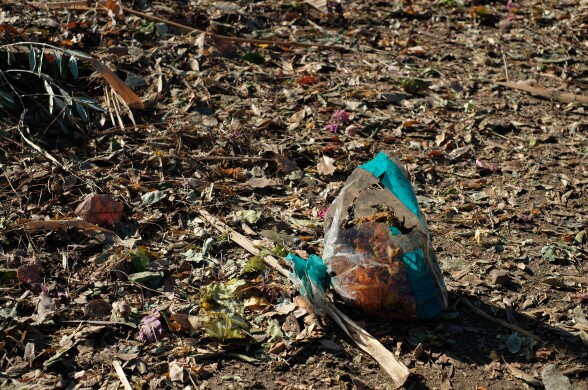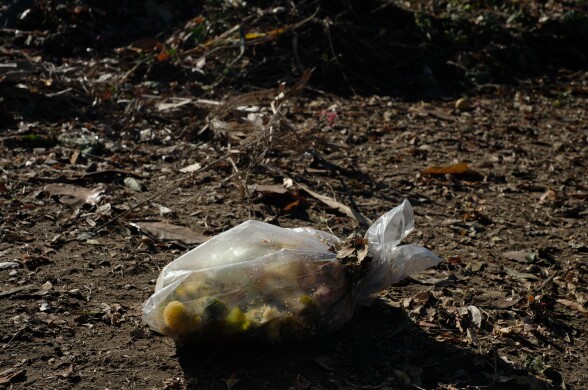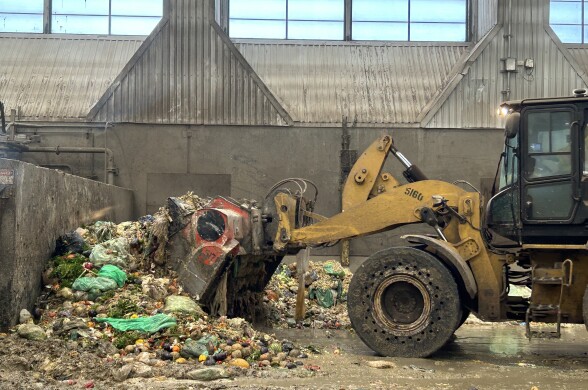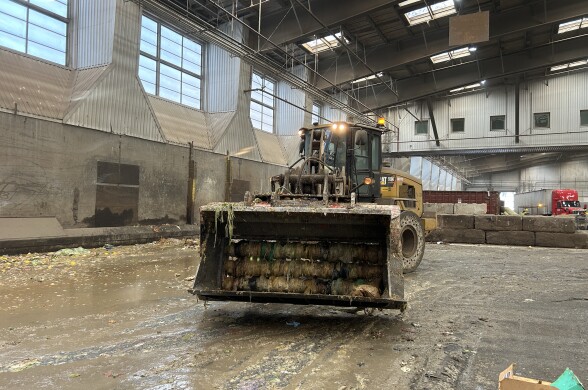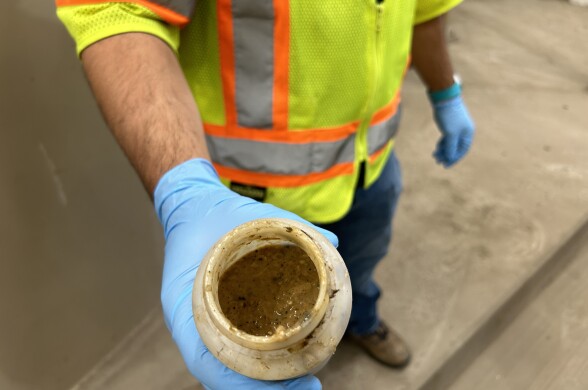This story is free to read because readers choose to support LAist. If you find value in independent local reporting, make a donation to power our newsroom today.
Put food waste in plastic bags? We found out why
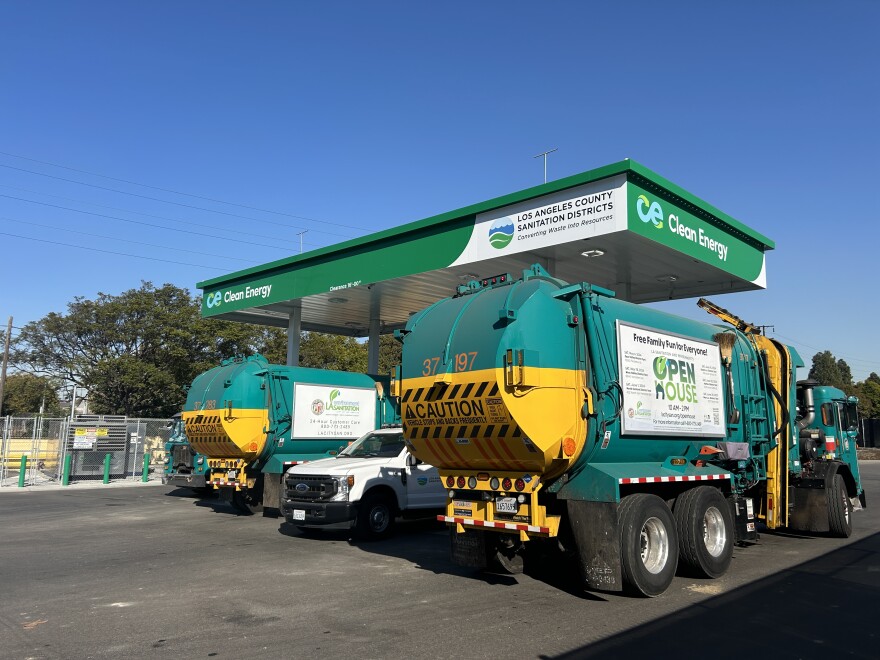
You might remember our food waste guide from earlier this year — we received questions from more than 500 of you about California’s recent law to keep food waste out of landfills.
One question we got a lot: Why do some cities, such as Pasadena, require us to bag our food waste before putting it in the green bin? I went on a food waste journey to understand why.
When you drive on the 134 Freeway, between Glendale and Pasadena…you may have admired the mountains opposite the view of downtown L.A. Well, that mountain is actually a landfill…Scholl Canyon Landfill.
Since 1961, that landfill has grown with L.A. County’s waste — officials say it only has a few years of capacity left. About 500 trucks a day dump everything from trash to food waste there. Americans throw away about four pounds of trash per day — higher than anywhere in the world.
Step 1: Separating food waste
At the top of the landfill, workers pick through green waste spread across the ground, getting rid of plastic and other contaminants.
“ There's not automated magic to some of this handling of waste,” said Michael Chee, a spokesperson for L.A. County Sanitation Districts. “There are actually people in here digging and separating and pulling plastic out.”
A worker tosses a whole bag of raw chicken into a dumpster that’s half full of bagged food waste. Nearby, a coyote sneaks some nibbles from food waste not yet collected.

The workers are also grabbing bags of food waste to put in a separate dumpster. This is why cities such as Pasadena ask residents to separate their food waste in bags — ideally bags you already have, like bread bags, carrot bags or potato sacks, said Gabriel Silva, environmental programs manager with the city.
(Tip: It’s not worth buying more expensive “compostable” bags — they’ll be torn off and go to the landfill anyway and using bags you already have further reduces waste.)
Silva said the bagging helps them more easily separate the food waste from the yard waste because they’re going to different places. The yard waste will be composted and the food waste will be turned into fuel.
This isn’t how it’s done everywhere: Many jurisdictions are primarily composting their food waste. But it’s all part of California’s new law to keep food waste out of landfills, where it decomposes and releases methane…a climate super-pollutant.

Step 2: Turning food waste into slurry
Once the food waste dumpster at Scholl Canyon is full — once or twice a week, it gets trucked a half hour away to the Puente Hills Materials Recovery Facility.
There, in a huge warehouse, a frontloader lifts bags of food waste.
Will Chen, the supervising engineer, explained how an attachment on the frontloader shreds the bags so the food waste can be dropped into a hopper. The hopper then shreds the food waste itself, filters out contaminants, and eventually turns the food waste into a kind of slurry.
The slurry is then piped into storage tanks.
“We have meters that are trying to monitor how thick it is because that's pretty critical for us,” Chen said.
Thick like a smoothie, folks here like to joke.
The slurry has to be able to easily move through the pipes and eventually into a tanker truck so the food waste goes to its final destination: the A. K. Warren Water Resource Facility, a wastewater treatment plant, in Carson.
Step 3: Turning food waste into fuel
At the Warren facility in Carson, the food waste slurry goes into huge tan circular structures called anaerobic digesters.
“They store about 4-and-a-half million gallons of sludge, and that's where all the bugs are eating the material and converting it into gas,” Chen said.

Microscopic bugs eat the food waste and wastewater slurry, then convert it into methane gas. The gas from the food waste is then piped across the street to a new compressed natural gas, or CNG, station.
Types of biofuels
There are three main categories of biofuels:
- Ethanol, which is made almost entirely from corn
- Renewable diesel, which is made from crop-based vegetable oils such as soy, as well as used cooking oils or animal fat. About 70% of the diesel used in California is this type of diesel.
- Biogas, which is made from methane gas captured from livestock manure and landfills, and, now, from food waste.
These fuels are less carbon-intensive than traditional oil and gas, meaning they emit less carbon into the atmosphere to heat up the planet, but there are other environmental consequences, such as cutting down trees or depleting soil to grow massive amounts of soy and corn for fuel.
At the station on a recent day, there are L.A. city garbage trucks and other heavy-duty trucks already fueling up. The gas generated from food waste will also be sold to SoCalGas for use in their pipelines. About 5% of the gas SoCalGas currently delivers is from biofuels, according to the utility. They expect that to grow to 20% by 2030.
“We definitely see that there is a demand for CNG fueling, which is why we're doing this,” Chen said. “However, it's not going to be forever. I think CNG is going to have a place in the transportation sector until electrification technology and/or hydrogen also becomes more prevalent and more available.”

Chen said L.A. County has the capacity to process a lot more food waste than it’s doing right now, but the biggest change in waste management since recycling takes time to ramp up. As more jurisdictions implement their food waste programs, Chen expects to see the volume go up significantly.

In the long-term, if CNG demand goes down, he said they can instead use growing volumes of food waste for electrical generation on site — after all, the Warren site will be the hub of one of the world’s largest water recycling efforts over the next ten years, and that will require a lot more electrical power. They’ll also be able to export excess power to the grid.
”We may have to pivot where instead of this biogas going into the pipeline or transportation fuel, we're going to go for more electrical generation,” Chen said.
Infrastructure challenges
Infrastructure remains a challenge for increasing these efforts. L.A. County Sanitation Districts are in a good position to implement more biogas production because they already have the necessary infrastructure, Chen said. And as they transition their fleets to electric, Chen expects the carbon footprint of transporting that food waste to these facilities to go down significantly as well. Already, their trucks largely run on biofuels.
CalRecycle estimates that California needs as many as 100 new or expanded organic waste recycling facilities to recycle an additional 20 million to 25 million tons of organic waste every year.
The agency, which oversees the state's waste management, estimates there are now 20 operating standalone anaerobic digestion facilities, with six more planned, and 10 co-digestion facilities — like the Warren facility in Carson — with 10 more planned.

The state is providing more than $120 million in grants to help boost that infrastructure.
”In L.A. County alone we're estimating that there's 4,000 tons of food waste that's generated every day that needs to be diverted,” Chen said. “It's going to be a collective effort across the entire state, and it's going to be a long and kind of costly journey. I think we'll eventually get there, but there needs to be heavy investment put into the infrastructure that's needed.”
Does this all make sense?
Scientists say reducing methane is a key part of addressing human-caused climate change. While methane doesn’t stay in the atmosphere nearly as long as carbon dioxide, it’s about 80 times more powerful at heating up the planet.
In California, our main sources of methane are dairies, landfills and oil and gas operations.
Methane at landfills is primarily because of food waste decomposing. Methane at landfills is usually captured then “flared,” meaning burnt. Burning methane instead of just letting it escape is better for the climate, but it’s bad for local air quality.
Some landfills also use the methane they capture to create electricity — that’s what Glendale is planning at Scholl Canyon Landfill.

“ I think [using food waste for fuel] is definitely in the right direction,” Chen said. “Now, instead of it going to the landfill where it's basically left to rot in the ground, you're able to fuel trucks, you're able to produce power, you're able to heat people's homes with the trash that they would have otherwise just kind of forgotten about. So it really does push the needle in the right direction and help us be a lot more sustainable.”
Compressed natural gas does have fewer dangerous emissions than diesel, and doing something with that food waste helps eventually lower methane emissions from landfills. But Katherine Blauvelt, a researcher with Industrious Labs, a nonprofit think tank, said that doesn’t solve the problem of existing methane emissions from landfills.

“The big problem with putting too many eggs into the biomethane basket is that it creates misaligned incentives that perpetuate our current harmful take-make-waste system,” Bleauvelt said in an email to LAist. “Very simply put, you can’t turn waste into energy without a lot of waste, and landfilling food is a terrible waste of precious resources and money. We can create more jobs and spur economic development when a community does more than use something and trash it.”
The state is considering updating its landfill regulations to help address the issue.
Something else to consider? The cost. Turning food waste into fuel is a lot more expensive than tossing it in a landfill.

Aaron Smith, an agricultural and resource economics professor at UC Berkeley, questions whether it’s worth it.
“ To deal with these problems, you have to pick something, and right now the feasible thing to pick is biogas production from food waste,” Smith said. “But I think a downside sometimes is that you might end up locking in or using a mitigation method that ends up being more expensive than other options could be.”
The efforts to keep food waste out of landfills are partially why your trash bill has likely gone up. But as landfills fill up and methane pollution worsens climate change, it’s a tough problem to solve when we have so much food waste in the first place.
“You can imagine a much more efficient system where we wouldn't have as much waste, but given that we do have the waste and have to deal with it, then this seems like one of the only options,” Smith said.
Ultimately, the tougher, but more effective, solution is that we need to generate a lot less waste in the first place.




